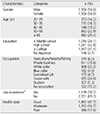Abstract
Purpose
The study purposes were to construct and test structural equation modeling on the causal relationship of community residents' perceived quality of care, image, and role performance with satisfaction, intention to (re)visit and intention to recommend hospital.
Methods
A cross-sectional survey was conducted with 3,900 community residents from 39 district public hospitals. The questionnaire was designed to collected information on personal characteristics and community awareness of public hospitals. Community awareness consisted of 6 factors and 18 items. The data were collected utilizing call-interview by a survey company. Research data were collected via questionnaires and analyzed using SPSS version 20.0 and AMOS version 20.0.
Results
Model fit indices for the hypothetical model were suitable for the recommended level: χ2=796.40 (df=79, p <.001), GFI=.93, AGFI=.90, RMSR=.08, NFI=.94. Quality of care, image, and role performance explained 68.1% of variance in community awareness. Total effect of quality of care process factors on satisfaction (path coefficients=3.67), intention to (re)visit (path coefficients=2.67) and intention to recommend hospital (coefficients=2.45) were higher than other factors.
References
1. Organization for Economic Co-operation and Development. OECD health data 2012. Paris, FR: Author;2015.
2. Korea Health Industry Development Institute. A study on the public healthcare plan and evaluation for enhancing public interest in public hospitals. Seoul: Author;2006.
3. Chung KS, Sim MB. Analysis of quality of life and satisfaction of community population in local government utilizing statistic methods. J Korea Assoc Land Admin. 2006; 13(1):111–144.
4. Lee GY, Kim Y. Efficiency evaluation of local public hospitals. Korean Soc Public Admin. 2008; 19(1):193–212.
5. Cho WH, Lee SH, Lee HJ, Chun KH. Medical service marketing. Seoul: Taeseoldang;1999.
6. Park JS. The causal relationship of health service quality, satisfaction, intention to revisit and intention to recommend perceived by health center visitors. Korean J Health Policy Adm. 2005; 15(3):60–78. DOI: 10.4332/KJHPA.2005.15.3.060.
7. Kim JH, Lee IS. The differences in quality perceptions, expectations, evaluation, and satisfaction for nursing service between patients and nurses: Small-medium sized general hospitals. J Korean Acad Nurs. 2004; 34(7):1243–1254.
8. Lee MA. A comparative study of how subjects' characteristics and nursing service quality influence on hospital revisiting intent between patients and nurses. J Korean Acad Nurs. 2005; 35(7):1210–1220.
9. Ji KJ, Park CM, Lee JY. Effect on perceived value, satisfaction, reuse intention of perceived quality of care by patients. Korea Health Study. 2011; 37(2):41–56.
10. Bopp KD. How patients evaluate the quality of ambulatory medical encounters: A marketing perspective. J Health Care Mark. 1990; 10(1):6–15.
11. Reidenbach RE, Sandifer-Smallwood B. Exploring perceptions of hospital operations by a modified SERVQUAL approach. J Health Care Mark. 1990; 10(4):47–55.
12. Negarandeh R, Hooshmand Bahabadi A, Aliheydari Mamaghani J. Impact of regular nursing rounds on patient satisfaction with nursing care. Asian Nurs Res (Korean Soc Nurs Sci). 2014; 8(4):282–285. DOI: 10.1016/j.anr.2014.10.005.
13. Grönroos CA. A service quality model and its marketing implications. Eur J Mark. 1984; 18(4):36–44. DOI: 10.1108/EUM0000000004784.
14. Marton K, Boddewyn JJ. Should a corporation keep a low profile? J Advert Res. 1978; 18:25–31.
15. Kim KY, Kim JY. Effects of oriental medical tourism packages images and recognition on purchase intention of consumers. Korea Tour Res Assoc. 2013; 27(3):5–20.
16. Keller KL. Conceptualizing, measuring, and managing customer-based brand equity. J Mark. 1993; 57:1–22.
17. Koo JY, Yu SH, Lee HJ, Sohn TY. A comparison of the recognition and satisfaction for health care service between internal customer and external customer. Korean J Health Policy Adm. 2000; 10(1):111–125.
18. Han AR. The effect of hospital image on customer satisfaction and revisiting intention: Focused on the dental hospital [master's thesis]. Asan: Soonchunhyang University;2013.
19. Yoon SW, Kim SB. The effects of physical environment, perceived justice and perceived waiting-time on repurchase intension. J Global Acad Mark Sci. 2003; 12(1):135–154. DOI: 10.1080/12297119.2003.9707208.
20. Ministry of Health & Welfare, Samil Pricewaterhouse Coopers. 2012 Public hospital evaluation programme: Survey report. Seoul: Samil Pricewaterhouse Coopers;2012.
21. Ministry for Health, Welfare and Family Affairs. 2009 public hospital evaluation programme: Survey report. Seoul: Author;2009.
22. Gunst RF. Regression analysis with multicollinear predictor variables: Definition detection and effects. Commun Stat Theory Methods. 1983; 12(19):2217–2260. DOI: 10.1080/03610928308828603.
23. Rho HJ. Social survey analysis utilizing SPSS/AMOS. 2nd ed. Seoul: Hyungseul;2005.
24. Hwang EJ, Moon J, Sim IO. The effects of quality of care, image, role performance perceived by community residents on medical service satisfaction to public hospitals. Health Policy Manag. 2014; 24(2):153–163. DOI: 10.4332/KJHPA.2014.24.2.153.
25. Korea Health Industry Development Institute. Establishment of management strategy and feasibility study of construction of district hospital. Seoul: Author;2008.
26. Park JS. The relationship of national university hospital inpatient's perceived quality, satisfaction, and customer loyalty. Korean J Hosp Manage. 2004; 9(4):45–69.
27. Wang MS, Lim NY, Jeong HC. The patient satisfaction of medical services and the revisiting intention in a public hospital. J Korea Acad Ind Coop Soc. 2013; 14(12):6275–6283. DOI: 10.5762/KAIS.2013.14.12.6275.
28. Geva A, Goldman A. Satisfaction measurement in guided tours. Ann Tour Res. 1991; 18(2):177–185. DOI: 10.1016/0160-7383(91)90002-S.
29. Lee HS. The impact of hospital selection factors between internal and external customers on hospital image. Health Policy Manag. 2013; 23(3):281–288. DOI: 10.4332/KJHPA.2013.23.3.281.
30. Korea Ministry of Government Legislation. Public health act [Internet]. Sejong: Author;2015. cited 2015 April 12. Available from: http://www.law.go.kr/main.html.




 PDF
PDF ePub
ePub Citation
Citation Print
Print







 XML Download
XML Download